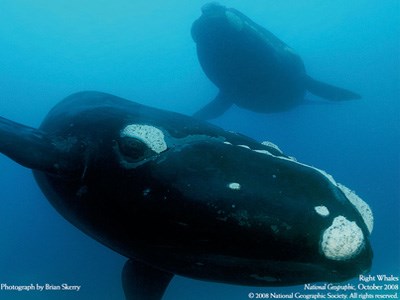
National Geographic Society 2008 It’s big. It’s slow. It floats when dead. It was plentiful close to shore, and it was full of valuable oil and baleen. Hence, for the whalers of years ago, it was the “right whale” to hunt and kill. Because of this over hunting, which continued until 1935, the northern right whale is now close to extinction with only about 300 whales left. This makes them the most endangered large mammal in the world. (A similar species, the southern right whale, lives in southern oceans and numbers perhaps 2000 individuals worldwide. However these two populations do not mix.) Right whales, growing up to 55 feet (17 meters) long, are black and have a broad, flat back with no dorsal fin. They have two blowholes and thus spout in a V-shaped blow. The head is often covered with wart-like patches called callosities which help researchers identify individuals since each whale’s callosity pattern is different. Second only to the giant blue whale in weight, the right whale can weigh up to 50 tons—all on a diet of tiny zooplankton that it strains from the water with the plastic-like baleen inside its mouth. In earlier days, this baleen was made into stiffening stays for women's corsets. The north Florida coast, including the area just off the shore at Fort Matanzas, is a special place for these whales—this is where they come to give birth each year during the winter months. It had been known for years that these whales feed in the cooler water off Cape Cod, Massachusetts and the Bay of Fundy in Nova Scotia during the spring and summer, but then the whales seemed to disappear. No one knew where they spent the colder months or where the calving grounds were. Finally, in 1979, a right whale female and her calf were sighted off the coast of Georgia. By her markings the mother was identified as one seen off Nova Scotia during previous summers. Further observations of other occasional whale sightings over the years have shown that the waters of the southern U.S. are the only known calving ground for the species. This area is a narrow strip of water extending only 5-15 miles offshore from the Altamaha River in Georgia south to the Sebastian Inlet in Florida. Unfortunately for the whales, this area contains major shipping lanes and the ports of Brunswick, Fernandina, Jacksonville, and Canaveral as well as the Kings Bay Submarine Base and Mayport Naval Station. Right whales are especially slow moving when the mother is with her calf. The pair will spend a significant amount of time at the surface where they are extremely difficult to see. This exposes the whales to the threat of collision with ships and causes 30% to 50% of whale deaths. For their already low population, this percentage is bad news. Entanglement in fishing gear is another problem for the right whale which will come as close inshore as the surf line at times. Funding from the Navy, the Coast Guard, and the Army Corps of Engineers has set up an Early Warning Aerial Survey Program. Each day a team flies over the high use area and radios back the locations of whales so that ships can avoid them. Since this program has been in place, ship and whale collisions have lessened. This program also relies heavily on teams of trained volunteer whale watchers through the Marine Resources Council Volunteer Sighting Network who scan the ocean through binoculars several times a day looking for the tell-tail V-shaped spout and the gray shapes of whales. In fact, with government funding cuts, the volunteers are becoming even more important to the success of the program. Unless there is a financial windfall, only volunteers will be scanning the miles of beach from the Matanzas Inlet to Sebastian. Therefore, even chance sightings by private citizens are important and add to the research about these endangered whales. In previous years, due to the combined efforts of volunteers and researchers, many new whales have been identified. You can help, too. If you see a Right Whale, call 1-888-979-4253. Look for-- (1) white spots on the head, (2) NO dorsal fin, and (3) the V-shaped blow. Have the following information ready: • The location of the whale(s)-- latitude and longitude, if known, or nearby landmark, beach access ramp, etc. • Number of whales and if there are any calves. • Direction the whale(s) are traveling. • Your name and a call back number You can also follow the right whale sightings on the Internet through the Navy's Fleet Area Control and Surveillance Facility web page at http://www.facsfacjax.navy.mil and follow the link at the top to the Whale Information page. |
Last updated: January 1, 2025
